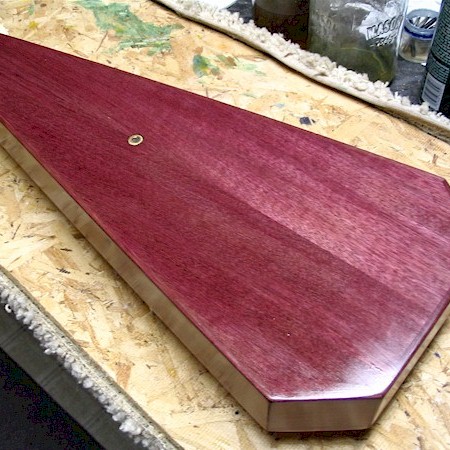
To prolong the color this wood should be finished with a UV. It should be noted that the bright purple color will fade to a darker brownish plum. It grows from Mexico through Southern Brazil. Indian Rosewood Ebiara English Brown Oak Figured Bubinga Figured Katalox Figured Makore Figured Mango Figured Purpleheart Figured Walnut Figured Zebrawood Flame Birch Gaboon Ebony Genuine Mahogany Goncalo Alves Granadillo Grey Box Burl Guanacaste (Parota) Hard Maple Hard Maple Burl Hickory Holly Honduras Rosewood Honduras Rosewood Burl Honey Locust Indian Ebony Jarrah Burl Jatoba Katalox Kingwood Koa Lacewood Leopardwood Lignum Vitae (Argentine) Lignum Vitae (Genuine) Macassar Ebony Madagascar Rosewood Madrone Burl Makore Mappa Burl Marblewood Masur Birch Mayan Walnut Merbau Mirindiba Mopani Narra Nicaraguan Rosewood Olivewood Osage Orange (Argentine) Osage Orange (USA) Padauk Pau Santo Peruvian Walnut Pink Ivory Poplar Purpleheart Quarter Sawn Maple Quarter Sawn Red Oak Quarter Sawn White Oak Quilted Bubinga Quilted Sapele Quilted Western Maple Red Coolibah Burl Red Mallee Burl Red Oak Red Palm Redheart Rift Sawn Hard Maple Royal Ebony Santos Mahogany Sapele Shedua Snakewood Soft Maple Spalted Hackberry Spalted Maple Spalted Tamarind Spanish Cedar Sucupira Swamp Ash Tamboti Teak Thuya Burl Tornillo Tulipwood Walnut Wenge Western Maple Western Maple Burl White Ash White Oak Yellow Box Burl Yellowheart Zebrawood ZiricoteĢ00 E. Purpleheart is a very recognizable species due to the bright purple coloring. Its texture is medium and it has a nice natural luster.Exotic Wood Species Acacia African Blackwood African Mahogany Afrormosia Afzelia Burl Amazon Rosewood Amboyna Burl Ambrosia Maple Angelim Pedra Anigre Aspen Bark Pocket Maple Basswood Birch Birdseye Maple Black & White Ebony Black Palm Bloodwood Bocote Bolivian Rosewood Brazilian Ebony Brown Ebony Brown Mallee Burl Bubinga Buckeye Burl Butternut Camatillo Canarywood Chakte Viga Chechen Cherry Cherry Burl Cocobolo Cumaru Curly Cherry Curly Hard Maple Curly Narra Curly Oak Curly Pyinma Curly Soft Maple Curly Western Maple Curly White Ash E. Grains are typically straight but can occasionally be interlocked. Its hues tend to be generally pastel in nature, so it makes a very complimentary, aesthetically unimposing wood for a variety of interior applications. Ideal for inlay, marquetry, and other fine.

The heartwood and sapwood of Anegre are usually not distinguishable from each other.Īnegre has a medium texture with closed pores similar to Maple.¬† The species is easy to work with both hand and power tools.Įxamples can be quite beautiful - and sometimes stunning, with curly and mottled figuring being not uncommon. A brilliantly colored hardwood from South America, Purpleheart is very popular for its deep purple color. Anegre typically darkens to a golden-to reddish brown over time, with repeated UV ray exposure. Its colors can range from pale yellowish to orangish-brown wood, to a pale pinkish-brown, sometimes with additional highlight coloration. The wood’s aesthetics can vary greatly, as Anegre is comprised of three separate species within the Pouteria genus. Purpleheart wood comes from trees within the peltogyne genus, which encompasses more than 20 different species of trees that are native to the tropical. Indigenous to the tropical regions of East Africa and West Africa, as far south as Angola.¬† Anegre has been used primarily as an interior wood it is decidedly non-durable, and thus not recommended for outdoor applications. He suggests a thicker finish will work better. Our in-house woodworking specialist has had excellent results with Osmo PolyX. The brittleness makes it less suitable for intricate cabinetry, but it is still an excellent choice for less intricate items such as floors, tops, panels, cladding etc.Įxtra care needs to be taken when finishing thermally modified wood, as the “bone dry” wood has a tendency to “suck in” much of what is given to it. This makes it chip a little easier than the un-modified lumber. The thermally modified wood is more dimensionally stable, but the process does reduce bending strength and make the wood a little more brittle. It darkens the wood to a beautiful rich chocolatey brown color whilst still showing the gorgeous grain and figure of the underlying wood.

The process is natural and chemical free. The heat removes organic compounds from the wood cells, changing both the physical and chemical make-up of the wood. “Roasting” Flame Birch involves gradually heating the wood up to temperatures of greater than 160 degrees celcius in special heat chambers made of stainless steel under anoxic conditions.


 0 kommentar(er)
0 kommentar(er)
